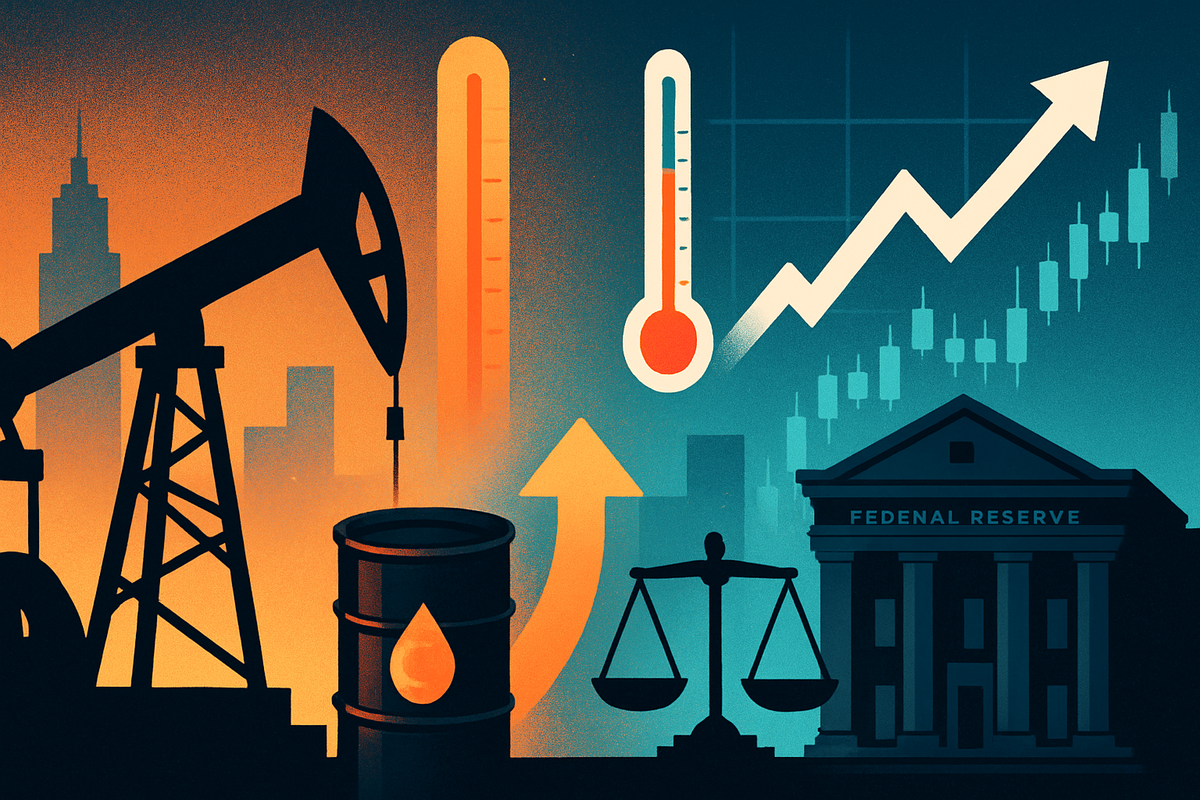
New York, NY – October 23, 2025 – Global financial markets are once again grappling with the specter of rising oil prices, a development that has reignited inflation anxieties and complicated the Federal Reserve's carefully orchestrated monetary policy. A recent surge in crude oil futures, primarily driven by new U.S. sanctions against Russian oil companies, has sent ripples across commodity and equity markets, forcing investors to reassess the delicate balance between economic growth and price stability. This immediate upward pressure on energy costs arrives at a pivotal moment when the Federal Reserve is actively pursuing an easing cycle, prioritizing a softening labor market over stubbornly persistent inflation.
The confluence of geopolitical risks escalating oil prices and the Fed's dovish pivot creates a complex and potentially volatile environment for public companies and consumers alike. While the immediate implications include a boost for energy sector stocks, broader market indices are showing signs of strain as the cost of doing business and living expenses are poised to climb. The central bank's commitment to lowering borrowing costs to stimulate economic activity now faces a renewed challenge from external inflationary forces, potentially leading to a re-evaluation of its forward guidance and a period of heightened uncertainty for financial assets.
Oil's Resurgence: Sanctions, Supply, and the Shifting Economic Tide
The latest episode of oil price volatility unfolded dramatically on October 23, 2025, as both WTI and Brent crude futures experienced significant gains. WTI crude oil futures surged over 5% to settle above $61 per barrel, reaching a two-week high of $61.43 USD/Bbl, while Brent crude climbed to between $65.44 and $65.83 per barrel. This sharp upward movement was directly triggered by the United States' announcement of fresh sanctions targeting key Russian state-owned oil entities, notably Rosneft PJSC and Lukoil PJSC. These punitive measures, aimed at intensifying pressure on the Kremlin over the ongoing conflict in Ukraine, carry the potential to disrupt a significant portion of global oil supply, particularly to major importers like India and China.
The timeline leading up to this moment has been characterized by a broader narrative of supply-demand dynamics and geopolitical instability. While the immediate catalyst was the sanctions, the oil market has been operating under the shadow of anticipated oversupply in the medium term. Analysts from institutions like J.P. Morgan and the EIA had previously forecasted a potential downturn in prices for late 2025 and 2026, citing factors such as the accelerated unwinding of OPEC+ production cuts, robust non-OPEC production growth (especially from North American shale basins), and a slower-than-expected global demand recovery amidst macroeconomic headwinds. However, the unexpected imposition of new sanctions has temporarily overridden these supply-side expectations, injecting a fresh dose of risk premium into crude prices.
Key players in this unfolding scenario include the U.S. government, whose policy decisions directly impacted the market, and the targeted Russian oil companies (Rosneft PJSC and Lukoil PJSC). OPEC+, as the cartel responsible for managing global oil supply, also remains a critical stakeholder, with its future production policies now potentially subject to renewed scrutiny in light of geopolitical disruptions. Initial market reactions have been mixed but pronounced. Energy companies, such as Shell (LSE: SHEL) and BP (LSE: BP), saw their share prices climb, contributing to gains in indices like the FTSE 100. Conversely, major U.S. equity indices, including the S&P 500, Dow Jones Industrial Average, and Nasdaq Composite, experienced declines, reflecting broader concerns about inflation and weaker-than-expected corporate earnings from some sectors. Bond markets also reacted, with the yield on 10-year US Treasuries climbing to 3.99% as inflation concerns resurfaced, even as money markets continued to price in aggressive Fed rate cuts, highlighting a disconnect in market expectations.
Corporate Fortunes: Winners and Losers in an Era of Expensive Oil
The latest surge in oil prices will inevitably create a distinct divide between corporate winners and losers across various sectors of the economy. For companies heavily involved in oil and gas exploration, production, and refining, higher crude prices generally translate into increased revenues and profitability. Integrated energy giants such as ExxonMobil (NYSE: XOM), Chevron (NYSE: CVX), and Shell (LSE: SHEL), along with smaller independent producers, are poised to benefit significantly. Their upstream operations will see improved margins, and their stock prices often rally in response to sustained increases in commodity prices, as evidenced by the recent boost to European energy majors. Service companies supporting the oil and gas industry, like Schlumberger (NYSE: SLB) and Halliburton (NYSE: HAL), could also see increased demand for their drilling and exploration services.
Conversely, industries with high energy consumption or significant transportation costs will face considerable headwinds. The airline industry, represented by carriers like American Airlines (NASDAQ: AAL) and Delta Air Lines (NYSE: DAL), is particularly vulnerable, as fuel is typically one of their largest operating expenses. Higher jet fuel costs directly erode profit margins and can lead to increased ticket prices, potentially dampening consumer demand for travel. Similarly, logistics and shipping companies, including FedEx (NYSE: FDX) and UPS (NYSE: UPS), will incur higher expenses for their vast fleets of trucks and aircraft, impacting their bottom line and potentially leading to surcharges for customers. Manufacturing sectors, especially those relying on petrochemicals or energy-intensive processes, will also see their input costs rise, squeezing margins and potentially leading to higher prices for consumers, further fueling inflation.
Beyond direct energy consumption, consumer discretionary companies could also suffer. As gasoline prices rise, consumers have less disposable income for non-essential goods and services, affecting retailers, restaurants, and entertainment venues. Automotive manufacturers like General Motors (NYSE: GM) and Ford (NYSE: F) might experience a shift in consumer preference towards more fuel-efficient vehicles, impacting sales of larger, less efficient models. The agricultural sector will also feel the pinch, as the cost of fuel for farm machinery and fertilizers (which are energy-intensive to produce) increases, potentially leading to higher food prices. Ultimately, while energy companies celebrate, a broad spectrum of the corporate landscape will be forced to absorb higher costs, pass them on to consumers, or find efficiencies to maintain profitability in this challenging environment.
Wider Significance: A Return to Stagflationary Concerns?
The resurgence of oil price volatility and its inflationary implications fit uneasily into broader economic trends, particularly the ongoing debate about the potential for stagflation. As of October 2025, the U.S. annual inflation rate, at 2.9% in August, remains above the Federal Reserve's 2% target, with core inflation also elevated. The latest oil price surge threatens to exacerbate this, pushing the September inflation figures (expected October 24) potentially higher. This scenario—high inflation coupled with a softening labor market (unemployment at 4.3% in August) and slowing economic growth—bears uncomfortable resemblances to the stagflationary periods of the 1970s. The Fed's current easing bias, aimed at supporting employment, directly conflicts with the need to quell price pressures, creating a difficult policy dilemma.
The ripple effects of sustained high oil prices extend far beyond immediate energy costs. Competitors in various industries face uneven playing fields, with some better positioned to absorb or pass on costs than others. For instance, airlines with more fuel-efficient fleets or better hedging strategies might fare better than their peers. Partners in supply chains will also feel the strain, as higher transportation costs impact the entire value chain from raw materials to finished goods. This could lead to renegotiations of contracts, shifts in sourcing strategies, and increased pressure for localization to mitigate shipping expenses.
Regulatory and policy implications are significant. Governments might face renewed calls for energy subsidies, strategic petroleum reserve releases, or even price controls, though the latter is generally avoided in market economies. The U.S. sanctions against Russia highlight the increasing weaponization of economic policy, adding a layer of geopolitical risk premium to commodity markets that is difficult to predict or hedge against. Such actions also prompt other nations, like China and India, to diversify their energy sources and potentially seek alternative payment mechanisms to circumvent future sanctions, fostering a more fragmented global energy landscape. Historically, sudden oil shocks, such as those in the 1970s and early 2000s, have consistently preceded economic slowdowns or recessions, serving as a stark reminder of crude oil's pervasive influence on global economic stability.
What Comes Next: Navigating a Path of Uncertainty
Looking ahead, the short-term outlook for oil prices and monetary policy remains highly uncertain, characterized by a delicate interplay of geopolitical developments, supply-demand fundamentals, and central bank reactions. In the immediate future, sustained U.S. sanctions on Russian oil could keep prices elevated, particularly if major buyers struggle to find alternative sources or if Russia retaliates by curtailing its own exports. This would likely intensify inflationary pressures, forcing the Federal Reserve to reconsider the pace and extent of its anticipated rate cuts. While the market is currently pricing in a high probability of another 25-basis-point cut at the October 28-29 FOMC meeting, and potentially another in December, a significant and prolonged oil price surge could introduce hawkish dissent within the Fed, potentially leading to a slower easing cycle than currently expected.
In the long term, however, the narrative of potential oversupply in the oil market persists. Despite the current geopolitical shock, projections for early 2026 still point towards supply growth outpacing demand recovery, driven by robust non-OPEC production and the eventual unwinding of OPEC+ cuts. This suggests that while immediate spikes are possible, sustained high prices might be challenged by fundamental supply dynamics. Potential strategic pivots for companies will include a renewed focus on energy efficiency, diversification of supply chains, and hedging strategies to mitigate fuel price volatility. Market opportunities may emerge in renewable energy sectors, as high fossil fuel prices make alternatives more competitive, and in companies with strong balance sheets that can weather economic headwinds.
Potential scenarios range from a "soft landing" where the Fed successfully engineers a gradual economic deceleration while bringing inflation under control, to a more challenging "stagflationary" outcome if oil prices remain high and economic growth falters. Another scenario involves a rapid resolution of geopolitical tensions, leading to a swift decline in oil prices and allowing the Fed to proceed with its easing plans unhindered. Investors should prepare for continued market volatility, with energy stocks potentially outperforming in the short term, while rate-sensitive sectors face ongoing pressure. The coming months will be critical in determining which of these paths the global economy will take.
Wrap-up: A Test of Resilience for Markets and Policy Makers
The current surge in oil prices, fueled by renewed geopolitical tensions and U.S. sanctions on Russian oil, represents a significant test for both financial markets and global monetary policymakers. The key takeaway is the immediate re-emergence of inflation as a prominent concern, directly challenging the Federal Reserve's current strategy of monetary easing, which aims to support a softening labor market. While the Fed is widely expected to cut interest rates again soon, the sticky nature of energy-driven inflation could force a more cautious approach, potentially slowing the pace of future cuts and keeping borrowing costs higher for longer than anticipated.
Moving forward, the market will likely remain in a state of heightened sensitivity to both geopolitical developments and economic data. The immediate beneficiaries are clearly the major oil and gas producers, whose profitability stands to increase. Conversely, industries heavily reliant on fuel and transportation, alongside consumer discretionary sectors, face mounting cost pressures that could erode margins and dampen demand. This divergence will likely lead to continued sector-specific volatility and a rotation of capital within equity markets.
Investors should watch closely for several key indicators in the coming months. The first is the trajectory of oil prices themselves, particularly how the market digests the new sanctions and the actual impact on Russian oil exports. Second, the upcoming inflation reports, especially the September CPI data, will be crucial in gauging the extent of price pressures. Third, the Federal Reserve's statements and actions at its upcoming FOMC meetings will be paramount, as any deviation from its dovish guidance could trigger significant market reactions. Finally, global economic growth data, especially from major energy consumers like China, will provide insights into demand-side dynamics. The ability of central banks to navigate this complex landscape, balancing inflation control with economic stability, will ultimately determine the lasting impact of this latest energy shock on the global financial system.
This content is intended for informational purposes only and is not financial advice


















